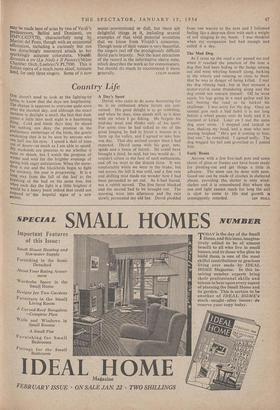GRAMOPHONE RECORDS
(INITIALS before catalogue markings indicate the following recording companies: B, Brunswick; C, Capitol; D, Decca; HMV; OL, Oiseau-Lyre' P, Parlophone; S, Supra- phone; T, Telefunken; V, Vox. A star indicates excellent quality. Unstarred issues may be taken as acceptably recorded where there is no comment to the contrary in the review.) Bach: Brandenburg Concertos Nos. 2 and 5/Berlin Chamber Orch. / Benda / T. LXG 66012; 4 Sonatas and Trios/Collegium Pro Arte/OL.50013. Both Brandenburgs are played with admirable accuracy and purity of style, but after the delightfully bright performance of No. 2, the playing of No. 5 is disappointingly mechanical, and draws attention to the note-spinning in the work itself. And neither the solo violin nor the brilliantly played continuo is prominent enough in comparison with the flute. In the four sonatas, more unusually, the con- tinuo is too heavily weighted, and combines with an imperfectly balanced recording to make the texture muddy. The works are not all the best Bach, but the D minor Trio for flute, oboe and harpsichord is magnifi- cent. The flute playing of Kurt Redel, both here and in the violin-like figuration of the E minor Sonata with harpsichord, is breath- taking in every sense. Beethoven: " Wald- stein" Sonata Annie Fischer / S.LPM62*; " Diabelli" and "Eroica" VariationslArraul B.AXTL1024-5. Fischer's playing has occa- sional wilful spurts and oddities, but it is beautifully clear, articulate and precise, and the whole conception is finely distinguished. Neither of the sets of variations is among Arrau's more illuminating interpretations, and there are sentimental passages in both, among many well but few very persuasively played. Gershwin: Piano Concerto in Fl Pennario/Pittsburgh Sym. Orch./Steinberg/ C.CTL7046*; also Kiinneke: ninzerische Suite for jazz band and orchestra/Berlin Phil./Kiinneke/T.LGX66013, and Bach Goes to Town and Bach Before the Mast/George Malcolm (harpsichord)/P.R3776(78). The Gershwin provides an interesting comparison with Ravel's two recently released piano concertos, which it faces at close quarters across the gap that divides serious music from jazz. The two composers owe each other much, and though Gershwin's techni- cal resource is less, his invention is not inferior, and it is strongly sustained here. He comes out of the comparison very well op all counts. Just how musically he solved a difficult problem can be judged from a further comparison, with Kunneke's preten- tious attempt to ,do something similar, or with the harpsichord pieces, all of which are as dismally lacking in wit as in musical substance. Both the performance and the recording of the Gershwin are first-rate. Haydn: Symphonies Nos. 96 and 97/Con- certgebouw Orch. / Beinum/ D. LXT 2847* ; String Quartets Nos. 18 and 68/Kalki/ T.LGM65014. The two symphonies can be recommended highly from every point of view. There is much fine playing in the quartets too, but they are less perfectly groomed and the recording is patchy. The earlier one contains the signature tune of Music in Miniature, which may recommend it to many. On the review copy the sides are wrongly labelled. Leoncavallo: Pagliacci/ S. Cecilia Acad. Chor. and Orch./Erede/ t..LXT2845-6. A generally crude perform- ance, with the main parts insensitively bawled by Mario del Monaco and Clara Petrella. There is some improvement, as in the music, in the second half, and some agreeable singing by Piero di Palma as Peppe. On the fourth side Monaco sings arias by Verdi and others. Verdi: Otello/ Vinay/ N.B.C. Sym. / Toscanini / H M V. A LP 1090-2. Not the impressive Otello of Vinay but the Iago of Giuseppe Valdengo is the outstanding feature of this set. A vocal characterisation at once so dramatically nialevolent and so purely musical must be a rarity in any listener's experience. The weaknesses are Herva Nelli's Desdemona, which is technically poor and interpretatively characterless, and the Cassio, most of whose singing is strained. This is perhaps the price one must pay for Toscanini, who con- ducts with authoritarian discipl;ne that brings ample reward in the wonderfully concerted team-work, in which the orchestra participates equally. The elegant, classically reserved score is beautifully clear and deli- cate, and the recording, except for a few rough patches, lets through all its detail. There is more Verdi on D.LW5050, where Welitsch sings two arias from Ballo in Maschera, in indifferent voice and style, though rather better than the two Queen of Spades arias on the other side. Mention may be made here of arias by two of Verdi's predecessors, Bellini and Donizetti, on HMV.C4237(78), characterfully sung by Marimi del Pozo, though with an occasional affectation, including a curiously but not too disturbingly mannered attack to her sparklingly accurate coloratura. Vivaldi: Serenata a ire (La Ninfa e li Pastore)/Milan Chamber Orch./Loehrer/V.PL7990. This is Italian opera of a much more aloof, intimate kind, for only three singers. Some of it now seems 'conventional or dull, but there are delightful things in it, including several examples of that vivid pictorial invention that we know from Vivaldi's concertos. Though none of their voices is very beautiful, the singers reel off the prodigiously difficult florid parts bravely. Not the least attraction of the record is the informative sleeve note, which describes the work as for connoisseurs, but should do much to recommend it more



































 Previous page
Previous page